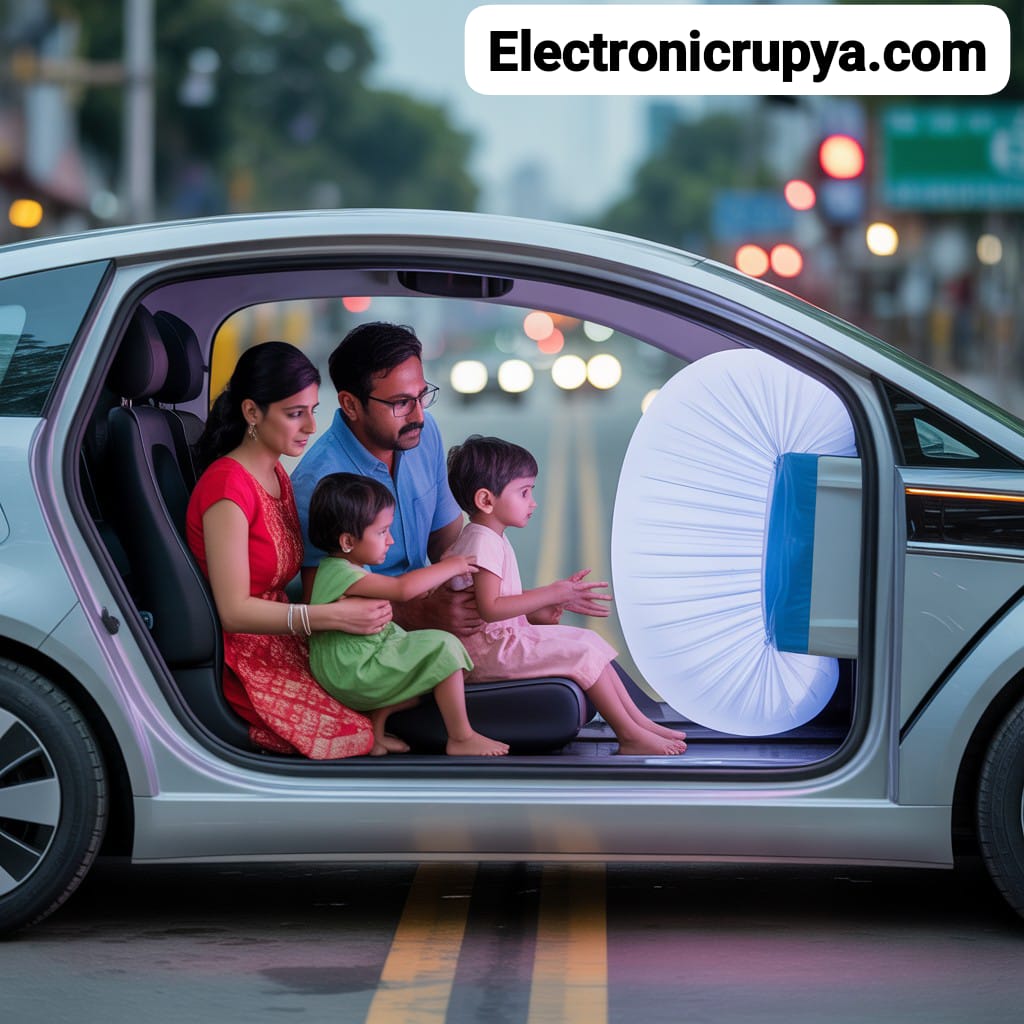INTRODUCTION
Electric Vehicles, or EVs, are becoming more and more popular in India and around the world. With rising fuel prices, pollution concerns, and the push for a cleaner environment, people are now shifting from petrol and diesel cars to electric ones. But as exciting as EVs are for the future, the most important thing for any vehicle is safety. Whether a car runs on petrol or electricity, it must protect the people sitting inside.
In this article, I will talk about some of the main safety features found in electric vehicles airbags, ADAS (Advanced Driver Assistance Systems), and crash ratings. These features help reduce accidents and save lives, making our roads much safer.
1. Airbags: Your First Line of Defense
Airbags have been used in cars for many years. They are one of the most basic yet most effective safety features in any vehicle, including electric ones. When a vehicle crashes, the airbags quickly inflate with air and form a cushion between the passengers and hard surfaces like the dashboard, steering wheel, or windows.
How Do Airbags Work?
The moment a car senses a sudden impact, the airbag system gets activated. A sensor detects the collision and sends a signal to the airbag control unit, which then triggers the airbags to inflate within milliseconds. The inflated bag helps absorb the force of the crash and prevents serious head or chest injuries.
Types of Airbags in EVs
Front Airbags: For the driver and front passenger.
Side Airbags: To protect during side collisions.
Curtain Airbags: These cover the windows and protect the heads of people sitting on the sides.
Knee Airbags: Found in some high-end EVs to protect legs during a crash.
Many modern EVs now offer 6 or more airbags as standard or optional, which shows how important safety has become in the automobile industry.
2. ADAS (Advanced Driver Assistance Systems)
ADAS stands for Advanced Driver Assistance Systems. These are smart safety features that use cameras, sensors, and radar to help the driver avoid accidents. ADAS is like having a co-driver that is always alert and helps make safer decisions while driving.
Important ADAS Features in EVs
1. Lane Keep Assist (LKA): Warns the driver if the vehicle is drifting out of the lane and gently moves it back.
2. Automatic Emergency Braking (AEB): If the car senses that it is about to hit something and the driver doesn’t react in time, it automatically applies the brakes.
3. Blind Spot Detection: Alerts the driver if there is a vehicle in the blind spot area, especially useful during overtaking.
4. Adaptive Cruise Control: Maintains a safe distance from the car in front by automatically adjusting the speed.
5. Traffic Sign Recognition: Reads road signs like speed limits and warns the driver.
6. Driver Attention Monitoring: Detects if the driver is sleepy or distracted and suggests taking a break.
Why ADAS is Important in EVs
Since EVs are usually silent and very quick in acceleration, having ADAS makes them safer.
Also, most EVs come with large digital displays and tech features, which can sometimes distract
the driver. ADAS helps to reduce human error, which is the cause of most road accidents.
3. Crash Ratings: How Safe is Your EV?
Crash ratings are given to cars based on how well they perform in various crash tests. These tests simulate real-life accident situations to see how much damage happens and how well the car protects the passengers. Organizations That Give Crash Ratings.
Global NCAP (New Car Assessment Program): Tests vehicles under global standards.
Euro NCAP: European version of crash tests.
Bharat NCAP: India’s own safety testing agency launched recently.
Crash tests usually include:
● Frontal crash test at 64 km/h
● Side crash test
● Pedestrian protection test
● Child safety test
EVs are put through the same crash tests as petrol or diesel cars. Many popular EVs like Tata Nexon EV or MG ZS EV have scored good ratings in Global NCAP tests, which gives buyers more confidence.
Are EVs Safe in Crashes?
Yes, electric cars are built with strong body structures and battery protection. The battery packs are usually placed under the floor and are protected by a solid metal casing. Also, EVs go through electrical safety tests to make sure there’s no short circuit, fire, or shock after a crash.
Some people worry about EVs catching fire, but modern EVs have multiple layers of safety. Fire risks are very low if the vehicle is built by a trusted company and used properly.
Additional Safety Features in EVs
Apart from airbags, ADAS, and good crash ratings, electric vehicles also offer:
Electronic Stability Control (ESC): Prevents the car from skidding or spinning.
ABS with EBD (Anti-lock Braking System + Electronic Brakeforce Distribution): Helps during emergency braking.
Tyre Pressure Monitoring System (TPMS): Alerts if tyre pressure is low.
Reinforced Safety Cage: Strong body to protect passengers in case of a rollover or crash.
Conclusion
Electric vehicles are not just the future of transportation; they are also getting safer with every new model. From airbags that protect us in a crash, to ADAS features that help prevent the crash in the first place, and crash test ratings that show us how well the car is built — EVs are now full of safety tech.
As more young people like us start driving and choosing vehicles for ourselves or our families, it’s important to look beyond just design and mileage. Safety should always come first, no matter how cool or advanced the vehicle is.
So next time you or someone you know is planning to buy an electric car, make sure to check how many airbags it has, what safety features it offers, and what its crash test rating is. Because at the end of the day, your life is priceless.







2 thoughts on “Electric Vehicle Safety Features-2025: Airbags, ADAS & Crash Ratings.”